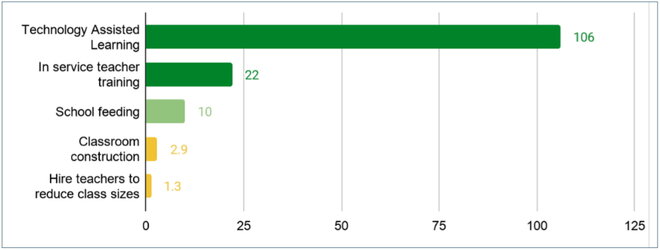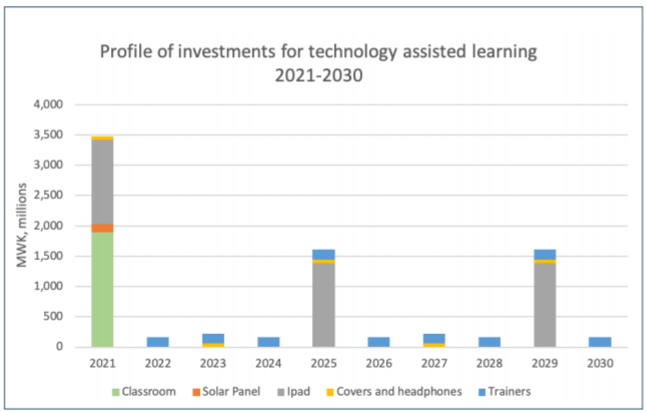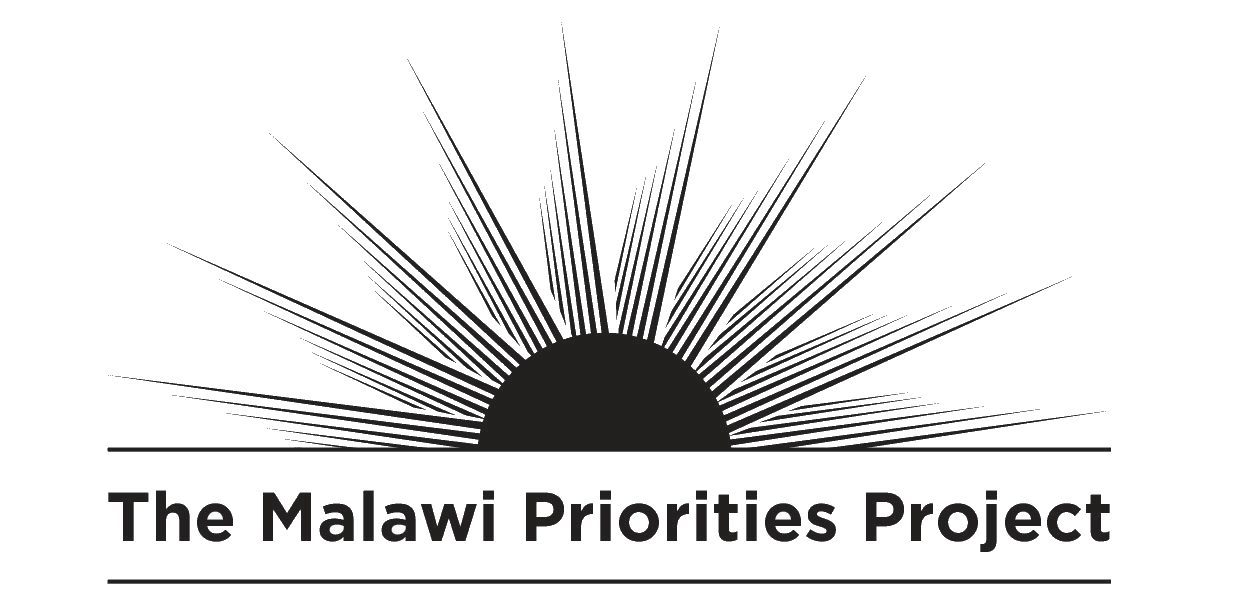Malawi Priorities: Primary School Education
Technical Report
Key Messages
- In spite of 88% enrollment rates in primary schools (pre-pandemic), learning outcomes are poor with the low passing rates for fundamental (English and Mathematics) subjects.
- The most cost-effective method identified to improve learning outcomes is Technology Assisted Learning (TAL). At an average annualized cost of MWK 11,200 per student per year, TAL has a benefit-cost ratio (BCR) of 106, meaning that 1 kwacha spent returns 106 kwacha in benefits, measured as increased future income for students.
- For a limited time per day, students go to a dedicated classroom to work individually with educational software, on a tablet, at their own pace. A study in Malawi showed that 8 months of TAL provided learning improvements equivalent to almost two years of normal instruction. The intervention simultaneously addresses high pupil-teacher ratios, variable teacher quality, and lack of infrastructure.
- Training teachers to improve educational outcomes also has an excellent yield in terms of additional future incomes worth 22 times the cost of the intervention.
- The analyses showed comparably low benefit-cost ratios for classroom construction (BCR = 2.9) and hiring teachers to reduce pupil-teacher ratios(BCR = 1.2).
- Malawian decision-makers should strongly consider marshalling additional funds to gradually expand, test, and refine this TAL program. This investment would deliver 88 times more improvements to educational outcomes than the same amount spent on hiring more teachers, or 37 times more than only constructing classrooms.
- In fact, by providing benefits worth more than 100 times the cost, TAL is one of the Malawi Priorities solutions showing the greatest value for money, which signals its viability as a government flagship project.
- To roll out the intervention to 50,000 students per year would require an upfront budget allocation of MWK 3,500 million to build classrooms, purchase solar panels, tablets, headphones, and covers. MWK 1,500 million would be required every four years to replace the tablets with a modest allocation of MWK 60 million every two years to replace the covers and headphones and MWK 165 million every year for staff
Context
Malawi has made great strides since primary education was made free to all students in 1994. This has encouraged many children to attend school. Enrollment rates for primary school students were at 97% in 2009 and 98% in 2015/16. The latest enrollment figures however show that only 88% of students (87% of boys and 89% of girls) were enrolled in primary education in 2017. Although these rates are still relatively high, this recent and rapid decrease is a cause for concern.
As part of recent development strategies, the government of Malawi identified education and skills development as one of its five priorities. 23.5% of the government’s budget is dedicated to education (UNICEF, 2019) In the recently released Vision 2063 document, improving education quality is highlighted as an enabler to achieve inclusive wealth creation and self-reliance.
Though the education sector receives a high proportion of the government budget, youth in Malawi are failing to learn and progress: Less than a quarter of students in Grade 2 pass English assessments, and only 40% pass Mathematics assessments. Repetition rates are consistently higher than 20% across all grades of primary school. These poor outcomes are due to a number of factors: high pupil-teacher ratios, particularly in early years, lack of school feeding, lack of infrastructure with the result that one-third of students learn outside, subject to rain, heat, dust, and other distractions, variable teacher quality with surveys demonstrating that teachers often do not have the skills to teach beyond grade 6 level, and spend a fifth of time off-task, as well as traditional gender norms and early marriage, which compel girls to drop out even before secondary school.
Therefore, the following question in the NPC’s research agenda is of utmost importance: How does Malawi most effectively improve the quality of education in primary schooling? Using cost-benefit analysis five solutions were evaluated in terms of social and economic value for each new kwacha invested.
Summary of findings
Primary education quality was the highest-ranked priority by sector experts consulted for the Malawi Priorities study. The findings of this report suggest that education interventions can bring about substantial benefits to the people of Malawi. The five interventions considered in this analysis are school construction, reduced class size, in-service teacher training, school feeding, and Technology-Assisted Learning (TAL).
Among the interventions analyzed, the educational return per kwacha spent on TAL is almost five times greater than the second-best intervention (teacher training) and more than 30 times that of reduced class sizes, and school construction interventions.

An important caveat of the analysis is that it assumes that the government will undertake the necessary investments to maintain the status quo in terms of classroom construction and hiring of teachers going forward, as the primary-school-age population grows. The results suggest that if additional funds are available, they should be directed towards technology-assisted learning, followed by in-service training.
Strongest Performing Intervention: Technology-Assisted Learning
The intervention with the highest BCR is a particular type of Technology Assisted Learning (TAL), where students:
A. engage individually with high-quality education software
B. can proceed through the curriculum at their own pace
and,
C. are guaranteed an indoor learning environment when
using the software
The intervention requires a specially built classroom with a solar charging panel and locked storage space for tablets. Students use the software in this classroom for up to an hour each day, with an individualized account that allows for progression through the curriculum at the student’s desired pace. The software does not require internet connectivity for use. A study in Malawi showed that the intervention, delivered over 8 months, provided learning improvements equivalent to almost two years of normal instruction. This is because this particular TAL intervention addresses three major constraints of the education system simultaneously: high pupil-teacher ratios, variable teacher quality, and lack of infrastructure.
Additional Government or Donor Investment Required
This intervention involves some level of classroom construction but the majority of funds, on a per child per year basis, are directed towards hardware. Scaling of the TAL intervention to 50,000 students per year would require investments for 100 classrooms every 20 years, 100 solar panels every 10 years, 6,000 iPads every 4 years, 6,000 headphones and covers every 2 years, and roughly 7 additional staff members annually. The profile of these costs is presented in Figure 2, shown only until 2030. It is clear that the main investment is in the first year, at almost MWK 3,500 million. Periodic replacement of tablets represents the next most costly element.

Benefits as Increased Lifetime Earnings
The increase in learning brought about by the intervention is estimated to deliver two years’ worth of equivalent learning, boosting students’ lifetime earnings by 22%. The present value of this gain is equal to approximately MWK 1,200,000 over a 30-year working career. All of the benefits accrue directly to primary school learners.
Summary Table
| Intervention | BCR Rating | Beneficiary Group | Investment cost | Benefits |
|---|---|---|---|---|
| Technology Assisted Learning | 106 Excellent (100% economic benefits) | 50,000 primary school students annually | MWK 3.5 billion in the first year; after which MWK 2.1 billion every four years | 2 years of learning 22% increase in lifetime earnings, MWK 1,200,000 per student |
| In-service teacher training for 715 teachers | 22 Excellent (100% economic benefits) | 50,000 primary school students annually | MWK 960 million (per cohort spread over three years) | 0.7 years of learning 8% increase in lifetime earnings MWK 417,000 per student |
| School feeding | 10 Good (100% economic benefits) | 50,000 primary school students annually | MWK 1.6 billion every year | 0.6 years of learning 7% increase in lifetime earnings MWK 313,000 per student |
| Classroom construction | 2.9 Fair | 70,000 primary school students annually | MWK 19.2 billion upfront | 0.09 years of learning 1% increase in lifetime earnings MWK 54,000 per student |
| Hire teachers to reduce class sizes | 1.3 Fair | 70,000 primary school students annually | MWK 2.2 billion every year | 0.09 years of learning 1.1% increase in lifetime earnings MWK 57,000 per student |
Note: BCRs are based on costs and benefits discounted at 8% (see accompanying technical report). BCR ratings are determined on the following scale Excellent, BCR > 15; Good, BCR 5-15; Fair, BCR 1-5; Poor, BCR < 1. This traffic light scale was developed by an Eminent Panel including several Nobel Laureate economists for a previous Copenhagen Consensus project that assessed the Sustainable Development Goals.
Download the full policy brief here.

